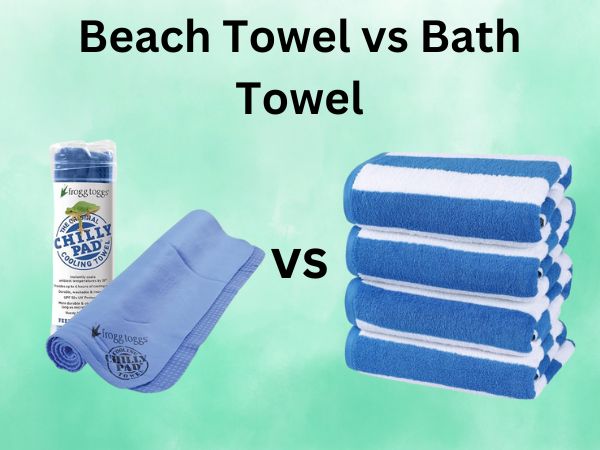Beach Towel vs Bath Towel [Which Should You Choose and When?]
Table of Contents
Understanding Towel Basics
What Makes a Towel a Towel?
Before diving into the differences, let’s talk about what makes a towel… well, a towel! At its core, a towel is a piece of absorbent fabric designed to remove moisture from surfaces – primarily your body. The magic happens thanks to something called “pile” – those tiny loops or cut threads that stand up from the base fabric and create surface area for water absorption.
The Evolution of Specialized Towels
Towels have been around for centuries, but they’ve evolved significantly. Ancient Roman and Turkish bath cultures pioneered the development of specialized cloths for bathing. Fast forward to today, and we have dozens of towel varieties designed for specific uses – from gym towels to kitchen towels, and yes, the distinct categories of beach and bath towels.
Beach Towels: Designed for Sun and Sand
Key Characteristics of Beach Towels
Beach towels have a personality all their own. When I unfold mine at the shore, I’m immediately reminded of their unique attributes:
- Larger size: Typically measuring around 30″ × 60″ or even larger.
- Thinner fabric: Helps dry faster, take up less space, and shed sand easily.
- Vibrant designs: Bright colors and patterns make them easy to spot and resistant to stains.
Materials Commonly Used in Beach Towels
Cotton Varieties in Beach Towels
Most quality beach towels are made from medium-length cotton fiber, balancing durability with a soft feel. Many feature velour on one side, which enhances smoothness and pattern visibility.
Microfiber and Other Synthetic Options
Microfiber beach towels have revolutionized the market. These towels dry quickly, repel sand, and fold down compactly. However, they often lack the cozy comfort of traditional cotton towels.
Bath Towels: Crafted for Bathroom Comfort
Defining Features of Bath Towels
Bath towels are designed for maximum water absorption in an indoor setting. Key characteristics include:
- Smaller size: Typically around 27″ × 52″, optimized for standing dry-off.
- Thicker fabric: Provides a plush, fluffy texture.
- Subdued colors: Designed to complement bathroom décor.
Bath Towel Materials and Construction
Egyptian and Turkish Cotton Options
Premium bath towels use long-staple cotton like Egyptian or Turkish varieties, offering superior absorption and a luxurious feel. Their high GSM (500-900) ensures plushness.
Bamboo and Sustainable Alternatives
Bamboo towels are gaining popularity for their softness and natural antimicrobial properties. They often blend with cotton for a balanced feel and fast drying.
Head-to-Head Comparison: Beach vs Bath Towels
Size and Dimensions: Why They Matter
- Beach towels: Typically 30″ × 60″ or larger.
- Bath towels: Generally 27″ × 52″.
Absorption Capabilities: Which Performs Better?
- Bath towels: Designed for maximum water absorption post-shower.
- Beach towels: Optimized for quick drying and multiple uses in outdoor settings.
Durability Factors: Sand, Sun, and Frequent Washing
- Beach towels: Resistant to sand, UV rays, and saltwater.
- Bath towels: Prioritize softness but are less durable in harsh environments.
Design and Aesthetic Differences
- Beach towels: Bold, colorful, and eye-catching.
- Bath towels: Elegant, often solid-colored or subtly textured.
Using the Wrong Towel: Consequences and Considerations
Taking a Bath Towel to the Beach
- Gets heavy and stays wet longer.
- Sand clings stubbornly.
- Colors fade due to sun and saltwater exposure.
Using a Beach Towel in Your Bathroom Routine
- Less effective at drying due to lower pile height.
- Awkwardly large for small bathroom spaces.
- Doesn’t blend well with bathroom décor.
Versatility: When Towels Cross Boundaries
Multi-Purpose Towel Solutions
Some hybrid options balance size, thickness, and absorbency, making them suitable for both beach and bath use.
Travel Scenarios and Space-Saving Needs
For travel, microfiber towels offer:
- Compact folding size.
- Fast drying capability.
- Versatility for both beach and bath settings.
Making the Right Choice: Purchase Considerations
Budget Implications and Value Assessment
- Bath towels: $20-$50 each, lasting 5-7 years.
- Beach towels: $25-$40 each, lasting 8-10 years.
Environmental Impact of Different Towel Types
- Cotton towels: Can be water-intensive; organic options are more sustainable.
- Microfiber towels: Shed microplastics when washed.
- Bamboo blends: More eco-friendly but may involve chemical processing.
Care and Maintenance: Extending Towel Lifespan
Beach Towels
- Shake out sand before washing.
- Wash in cold water to preserve colors.
- Avoid fabric softeners to maintain absorbency.
Bath Towels
- Wash in warm water to remove soap residues.
- Tumble dry on medium heat for fluffiness.
- Avoid bleach to protect fibers.
Frequently Asked Questions
1. Can I use a beach towel as a bath towel in a pinch?
Yes, but it won’t be as effective at drying you thoroughly due to its lower pile height.
2. Why do beach towels cost as much as bath towels despite being thinner?
Manufacturing beach towels involves specialized dyeing techniques, colorfast treatments, and reinforced edges, contributing to their cost.
3. How often should I replace my beach and bath towels?
- Bath towels: 5-7 years.
- Beach towels: 8-10 years.
4. Are quick-dry towels worth the investment for beach use?
Yes, especially for frequent beach-goers. They dry fast, resist sand, and are compact, though they may lack cotton’s softness.
5. What’s the best way to remove sand from beach towels before bringing them home?
Let the towel dry completely, then shake it vigorously. For stubborn sand, laying it in a breezy area can help dislodge particles.
Conclusion: Choosing the Right Towel for Every Situation
Understanding the unique properties of beach and bath towels helps you make informed choices. Investing in specialized towels enhances comfort, durability, and efficiency in their respective environments.


![5 Best Towel Racks for Large Towels [Ultimate Guide 2025]](https://bathroomexplorer.com/wp-content/uploads/2025/01/Best-Towel-Racks-for-Large-Towels.jpg)
![5 Best Bath Towels for Absorbency [In 2025]](https://bathroomexplorer.com/wp-content/uploads/2025/02/Best-Bath-Towels-for-Absorbency.jpg)

![5 Best Beach Towels for Boating [In 2025]](https://bathroomexplorer.com/wp-content/uploads/2025/02/Best-Beach-Towels-for-Boating.jpg)
![5 Best Towel Warmers for Barber Shops [A Complete Guide 2025]](https://bathroomexplorer.com/wp-content/uploads/2025/01/Best-Towel-Warmers-for-Barber-Shops.jpg)
![5 Best Cooling Towels for Golf [Beat the Heat and Improve Your Game]](https://bathroomexplorer.com/wp-content/uploads/2025/02/Best-Cooling-Towels-for-Golf.jpg)